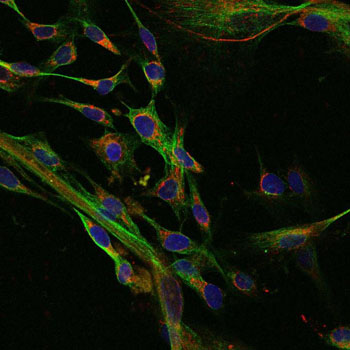Stem Cells Derived from Older Individuals May Carry Unsafe Mitochondrial DNA Mutations
By LabMedica International staff writers
Posted on 29 Apr 2016
Induced pluripotent stem cells (iPSCs) derived from the skin fibroblasts of older individuals have a likelihood of harboring mitochondrial DNA mutations, which may render them unfit for clinical applications.Posted on 29 Apr 2016
Logically, one would expect tissues from elderly individuals to be more likely to carry unfavorable mutations. However, when investigators at Oregon Health & Science University (Portland, USA) and their colleagues at Cincinnati Children's Hospital (Ohio, USA) examined the accumulation of somatic mitochondrial genome (mtDNA) mutations in skin fibroblasts, blood, and iPSCs derived from young and elderly subjects (24–72 years), they found that pooled skin and blood mtDNA contained few point mutations.

Image: A confocal microscopy image of human fibroblasts derived from embryonic stem cells. The nuclei appear in blue, while smaller and more numerous mitochondria appear in red (Photo courtesy of Dr. Shoukhrat Mitalipov, Oregon Health & Science University).
In contrast, a panel of 10 individual iPSC lines from each tissue or clonally expanded fibroblasts carried an elevated load of heteroplasmic or homoplasmic mutations, particularly in patients over 60. This finding implied that somatic mutations randomly arose within individual cells but were not detectable in whole tissues.
Further findings published in the April 14, 2016, online edition of the journal Cell Stem Cell revealed that the frequency of mtDNA defects in iPSCs increased with age, and that many mutations resided in RNA coding genes and thus could lead to respiratory defects. These results highlighted a need to monitor mtDNA mutations in iPSCs, especially those generated from older patients, and to examine the metabolic status of iPSCs destined for clinical applications.
"We call it the freckled effect," said contributing author Dr. Taosheng Huang, director of the mitochondrial medicine program at Cincinnati Children's Hospital. "Every single cell can be different. Two cells next to each other could have different mutations or different percentages of mutations. People tend to look just at the nuclear genome, but if you want to use iPS cells in a human, you must check for mutations in the mitochondrial genome."
Related Links:
Oregon Health & Science University
Cincinnati Children's Hospital













